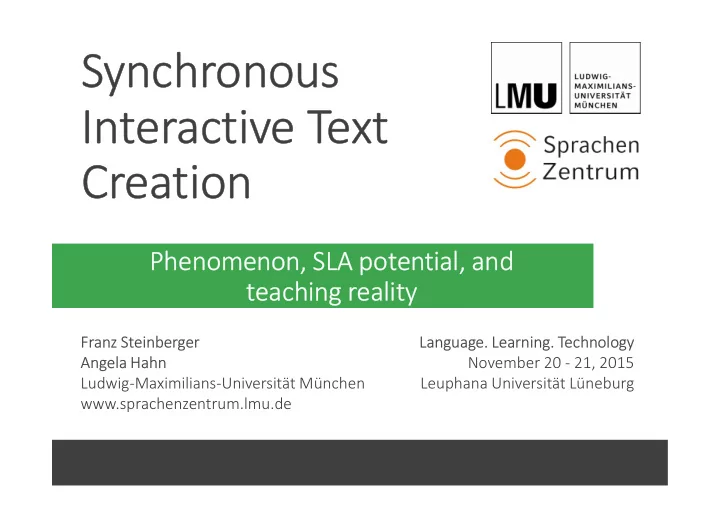

Synchronous Interactive Text Creation Phenomenon, SLA potential, and teaching reality Franz Steinberger Language. Learning. Technology Angela Hahn November 20 - 21, 2015 Ludwig-Maximilians-Universität München Leuphana Universität Lüneburg www.sprachenzentrum.lmu.de
Synchronous Interactive Text Creation: Shared documents technology Franz Steinberger: 18-Nov-15 2 Synchronous Interactive Text Creation
Franz Steinberger: 18-Nov-15 3 Synchronous Interactive Text Creation
Synchronous Interactive Text Creation 1. Shared documents technology 2. Theoretical background, teaching implications, and research question 3. Research study: data collection and research methodology 4. Research study: findings 5. Discussion Franz Steinberger: 18-Nov-15 4 Synchronous Interactive Text Creation
Theoretical background, teaching implications, and research question Franz Steinberger: 18-Nov-15 5 Synchronous Interactive Text Creation
2.1 Theoretical background and teaching implications Theoretical background: SLA Teaching implications Interaction Sociocultural Blended Learning: Action research Hypothesis Theory Bridging the gap & teacher role (Long 1996) (Vygotsky 1978) Franz Steinberger: 18-Nov-15 6 Synchronous Interactive Text Creation
2.2 Research question How does the Synchronous Interactive Text Creation process work? Q1: How do learners go about completing a joint task? Cooperation & Collaboration Communication & text (co-)ownership Q2: How do learners negotiate language form and meaning? Language-related episodes Revision types Franz Steinberger: 18-Nov-15 7 Synchronous Interactive Text Creation
Research study: data collection and research methodology Franz Steinberger: 18-Nov-15 8 Synchronous Interactive Text Creation
3.1 Research group & data collection Task Research Group Compose an English e-mail (‘patient English for medical purposes handover’) in 8 groups of 3 Blended Learning Google Docs only 24 German students, ~ C1 (CEFR) Time 45 minutes Data collection Screencast videos student evaluation chat logs Complete text revision history Franz Steinberger: 18-Nov-15 9 Synchronous Interactive Text Creation
3.2 Data-driven research approach Typology Develop RQs • Text revision • Collaborative patterns history • Participant • Synchronous • Language-related • Chat logs categories interactive episodes • Student (evaluation) editing behaviour • Text-ownership • Data-driven • User types evaluation categories (documents) Data collection Data analysis Franz Steinberger: 18-Nov-15 10 Synchronous Interactive Text Creation
Research study: findings (snapshot) Franz Steinberger: 18-Nov-15 11 Synchronous Interactive Text Creation
4.1 How do learners go about jointly completing a task? (Q1) Comments Text Chat Text Chat Time Franz Steinberger: 18-Nov-15 12 Synchronous Interactive Text Creation
4.1 Task completion process: Groups 1 and 2 Greet Summary of symptoms & diagnosis GROUP -ings Plan of 2 action Writing the e-mail Summary of symptoms, diagnosis, and GROUP Explicit treatment plan Writing the e- Plan of distribution 1 mail action of roles TIME 1 2 3 4 5 6 7 8 9 10 11 12 13 14 15 16 17 18 19 20 Franz Steinberger: 18-Nov-15 13 Synchronous Interactive Text Creation
Co-construction of text Cooperation Collaboration (group 1, 31 min) (group 1, 29 min) TEXT TEXT TEXT TEXT TEXT TEXT TEXT TEXT TEXT TEXT TEXT TEXT TEXT TEXT TEXT TEXT TEXT TEXT. TEXT TEXT TEXT TEXT. TEXT TEXT. TEXT TEXT TEXT TEXT TEXT TEXT TEXT TEXT. […] TEXT TEXT TEXT TEXT TEXT S1 S2 S3 TEXT TEXT TEXT. Franz Steinberger: 18-Nov-15 14 Synchronous Interactive Text Creation
4.2 How do learners negotiate language form and meaning? (Q2) ‘classic’ language-related episodes: Collaborative dialogue: ‘Languaging’ Negotiation for meaning VS Borderline cases: Implicit episodes: Language awareness? How to track attention? Franz Steinberger: 18-Nov-15 15 Synchronous Interactive Text Creation
4.3 First findings and implications Process-oriented • SITC/shared documents highly complex CMC definition • Actual usage > technological potential required Collaborative • Both patterns complementary patterns as a • Text co-ownership established quickly continuum Broader concept of • Implicit/explicit ‘languaging‘ not clear cut language-related • Learner attention difficult to track episodes needed Franz Steinberger: 18-Nov-15 16 Synchronous Interactive Text Creation
Last but not least… Have a go! Franz Steinberger: 18-Nov-15 17 Synchronous Interactive Text Creation
THANK YOU! franz.steinberger@lmu.de Download Presentation: http://www.lernhandwerk.de/lueneburg Franz Steinberger: 18-Nov-15 18 Synchronous Interactive Text Creation
Bibliography Gass, Susan M.; Mackey, Alison (2015): Input, Interaction, and Output in Second Language Acquisition. In: Bill VanPatten und Jessica Williams (Hg.): Theories in second language acquisition. An introduction. Second edition. New York: Routledge (Second language acquisition research), 180– 206. Long, Michael H. (1996): The role of the linguistic environment in second language acquisition. In: William C. Ritchie und Tej K. Bhatia (Hg.): Handbook of second language acquisition. San Diego: Academic Press, S. 413–468. Lantolf, James P.; Thorne, Steven L.; Poehner, Matthew E. (2015): Sociocultural Theory and Second Language Development. In: Bill VanPatten und Jessica Williams (Hg.): Theories in second language acquisition. An introduction. Second edition. New York: Routledge (Second language acquisition research), 207–226. Nguyen, Long V. (2013): Integrating computer-mediated communication into foreign language education a Vietnamese sociocultural context of higher education. München: LINCOM Europa (LINCOM studies in second language teaching). Storch, Neomy (2013): Collaborative writing in L2 classrooms. Bristol, Buffalo: Multilingual Matters (New perspectives on language and education). Swain, Merrill; Watanabe, Yuko (2012): Languaging: Collaborative Dialogue as a Source of Second Language Learning. In: Carol A. Chapelle (Hg.): The Encyclopedia of Applied Linguistics. Oxford, UK: franz.steinberger@lmu.de Blackwell Publishing Ltd. Franz Steinberger: Synchronous Interactive Franz Steinberger: 18-Nov-15 18.11.2015 19 19 Synchronous Interactive Text Creation Text Creation
Recommend
More recommend